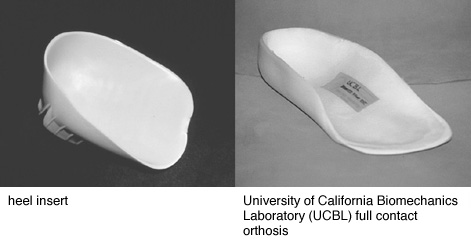Orthotic Devices
A foot pad or heel insert purchased at your local pharmacy or sporting goods store is an orthotic device. So is a custom-molded, individually designed shoe insert or ankle brace. Orthotic devices like these are frequently used to treat various conditions of the foot and ankle. They are often very effective in relieving common complaints.
Orthotic devices may be recommended for several reasons, including:
- aligning and supporting the foot or ankle
- preventing, correcting or accommodating foot deformities
- improving the overall function of the foot or ankle
For example, a wedge inserted into the inner (medial) side of the sole of a shoe can be used to help support a flatfoot, thus reducing the risk of tendinitis. An ankle-foot brace can help relieve the pain of rheumatoid arthritis in the heel or ankle. A heel flare can be used to increase support and help prevent ankle sprains. Heel cushions can help absorb impact and relieve stress on the heel and ankle when you walk or run. The type of orthosis recommended by your doctor will depend on your symptoms, the underlying cause for those symptoms, and the shape of your feet. In some cases, your doctor may prescribe an insert or pad; in other cases, modifications to your shoes may be necessary.
Although custom orthoses are considerably more expensive than off-the-shelf devices, they last much longer and provide more support or correction. In some cases, however, an over-the-counter device can be just as effective, particularly when combined with a stretching and exercise program. In the past, plaster molds of the foot were used to construct the custom-made orthosis. Now, computerized foot analysis is often used to develop orthoses that more accurately reflect the dynamics of your gait.
The chart below shows which orthotic devices are commonly recommended for various foot conditions. Consult your physician before buying or using an orthotic device on your own; if you select the wrong type of device, you could change the mechanics of your gait and cause problems instead of curing them.
|
Diagnosis
|
Recommended Orthotic Device
|
|
Bunions and/or bunionettes
|
Shoes with a wide toe box; soft, seamless uppers, stretchy shoes; "bunion shield" type pad
|
|
Corns and calluses
|
If located on or between the toes, a toe separator may be helpful.
|
|
Cavus foot (rigid high arch)
|
Soft orthotic cushions to distribute pressures evenly
|
|
Flatfoot (adult)
|
No device needed if there are no symptoms or pain. If there is pain or aching, a semirigid insert or long arch pad, inner heel wedge or extended heel counter may help.
|
|
Flatfoot (child)
|
No special orthotic device or shoe treatment is indicated. Most infants have flatfeet, and 97 percent will grow out of it.
|
|
Stiff big toe (hallux rigidus)
|
Full-length prefabricated stiff insert, Morton extension inlay, or rocker bottom sole
|
|
Hammer toe or claw toe
|
Shoes with a wide or deep toe box to accommodate the deformity; toe crest
|
|
Forefoot pain (metatarsalgia)
|
Wide shoes, pads or bars under the bones of the forefoot (metatarsals)
|
|
Limb length deformity
|
Custom-made full-contact orthosis
|
|
Morton neuroma
|
Shoes with a wide toe box, metatarsal pad positioned over the neuroma
|
|
Neuropathic ulceration (such as with diabetes)
|
Full-contact cushioned orthosis, extra-deep or custom shoes, rocker bottom sole to reduce pressure on foot
|
|
Plantar fasciitis (heel pain or heel spur)
|
Prefabricated heel insert made of silicone, rubber or felt
|
|
Runner's painful knee
|
Full-length, soft, prefabricated sport orthotic inlay to reduce stress and turning inward of the foot (pronation; flatfoot)
|

July 2002
All Information Copyright © American Academy of Orthopaedic Surgeons
www.aaos.org